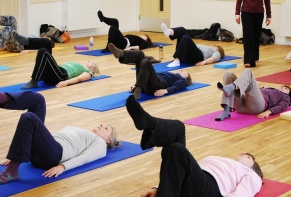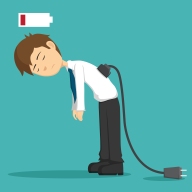by Jonathan Fitzgerald
Exercise? You mean… move?! Some days, your eyelids are protesting at the concept of blinking, so why on earth would you want to consider working your muscles when they feel like mashed potato?
There have been studies as recently as 2015 which suggest that, despite it seeming counter-intuitive (that’s formal speak for blumin’ crazy!), exercise might just help. On the other hand, there are mixed views on things like Graded Exercise Therapy as some believe it can have the opposite effect for some people.
This blog isn’t designed to cover the tricky topics of GET and pacing, but rather finding the right exercise for you – if you’re able – to increase those happy hormones and reduce deconditioning.
For me, I’m still a very active person in my mind and I find it highly frustrating that my body now won’t do what I thought it could. So I still play my football once a week, for the simple reason that it makes me happy, keeps me socialising and the minute I stop that, I’ll be on the slippery slope to being a couch potato.
That’s the 2nd potato reference… am I craving Vitamin B6?!… I’ll look at diet in a future blog!
So the questions are: What type of exercise is best for us Spoonies and how much? I’ve tested out a few…
Qi Gong: Awakening Energy within. My Energy Intensity rating out of ten: 2 
Recommended by my local NHS M.E rehab, this is described as internal acupuncture. Pronounced chi gong, it means “Life Energy Cultivation” and is a holistic system of coordinated body posture and movement, breathing, and meditation. It’s simple, slow-flowing movement and deep, rhythmic breathing to stimulate energy and is apparently very commonplace in the Eastern World. I recommend it; search on YouTube for Lee Holden Qi Gong as a great starting point.
Mind & Body: The slow-motion class! My Energy Intensity rating out of ten: 3
This 45-minute session was a mixture of things  like Tai Chi and Mindfulness, essentially divided into parts:
like Tai Chi and Mindfulness, essentially divided into parts:
– Standing stretches, reaches and other gentle movements to relaxing music, all the while focusing on slow, deep breathing.
– Sitting/laying down on the mat doing repeated, simple but varied movements / holds, a number of which involved a soft ball.
– Laying down in a comfortable position and being talked into and then out of a state of relaxation.
Originally for over-50s, its flexible nature of doing as much or as little as you like means it caters for anyone now. Not strenuous, not energising but relaxing in a good rather than exhausting way.
Yogalattes: More of a stretch – in every sense! My Energy Intensity rating out of ten: 7
Described as a workout that combines the best stretches from Yoga with the best core exercises from Pilates, I quickly worked out indeed that this was not the comparative picnic in the park of Mind & Body! The warm-up routine alone was more effort than anything we did in that class and my first clue was a slightly more upbeat tempo of music.
We went through a series of stretches, reaches, holds and moves. In some cases, there was lactic acid and I broke a little sweat although at no point did I feel like I was about to break any body parts too.
Some moves were about balance, some were about stretching muscles. Some were nice and some were tricky. A large number of the positions came with the message of ‘if that feels good, just do that, but if you want more, try this extra step’. It still had a calmer moment at the end with slower music and holding poses and felt core-strengthening.
So it was a flexible class – although you needed to be a little flexible yourself! When you’re doing moves called Down Dog, Striking Cobra and something about swan legs, you know it’s not a hammock, Jackie Collins book and Pina colada hour!
It can certainly be good to release our striking cobra once in a while but you may wish to at least start with something a little more sleeping sidewinder!
Body Balance: Similar to the above; a mix of yoga, pilates and Tai Chi. My Energy Intensity rating out of ten: 6
Hatha Yoga: A breath of fresh air. My Energy Intensity rating out of ten: 5 
Surprisingly relaxing in the main. Somewhere between Mind & Body and Yogalattes, the music pace was slow throughout and the emphasis was on deep breathing techniques, practicing postures and repetitive stretches. The tutor described it as being for the mind, body and soul, reconnecting with the body, recharging and letting go of things. There were a few tight stretches and a slow sweat worked up in the middle but in the main it was quite simple stuff like the Child’s Pose, then ending with lying down and being talked into and out of a relaxation state.
Gentle Pilates: Oiling the tin man’s hinges… My Energy Intensity rating out of ten: 5
Done to the pleasant pace of a Jack Johnson album, for those who know his chilled music,  this was simple (both standing and laying) reaches, stretches and twists. It felt like the joints, such as the back, knees and hips, were being loosened up in a manageable way. The C-crunch was as tricky as it got, although with my tight back, the ‘C’ more resembled some other letter attempting to contort itself into an italic. But that was OK as it felt like the gentle aches and pulls were doing some good. As with the others, it ended with 10 minutes of relaxation.
this was simple (both standing and laying) reaches, stretches and twists. It felt like the joints, such as the back, knees and hips, were being loosened up in a manageable way. The C-crunch was as tricky as it got, although with my tight back, the ‘C’ more resembled some other letter attempting to contort itself into an italic. But that was OK as it felt like the gentle aches and pulls were doing some good. As with the others, it ended with 10 minutes of relaxation.
Ashtanga Yoga … Not tried yet
Recommended due to it going to a rhythm but you can stop and only do, say, 2 of the 5 at any time. It is apparently a bit more physical but warms the muscles up and prepares them well.
Other sports: From creaking bones to croquet lawns. If there are other sports you enjoy,  or miss, or have always wanted to have a go at, it’s worth thinking about it for the mental health benefits too. Something like squash or the London Marathon is likely to be too intense but, in sensible moderation, why shouldn’t you get out and give yourself some healthy exercise? We talk about using our energy wisely and this seems a good choice to use some on. Start small – darts is classed as a sport! Is tiddlywinks?!
or miss, or have always wanted to have a go at, it’s worth thinking about it for the mental health benefits too. Something like squash or the London Marathon is likely to be too intense but, in sensible moderation, why shouldn’t you get out and give yourself some healthy exercise? We talk about using our energy wisely and this seems a good choice to use some on. Start small – darts is classed as a sport! Is tiddlywinks?!
Of course, these are just my experiences and the one thing that all the class instructors I quizzed said was that exercise tolerance is very much down to the individual. It certainly is with our M.E. bods, so my advice would be to experiment to see what you enjoy and how much is right for you. If, whilst still being realistic, you can then gradually increase it over time, that’s brilliant and is my aim! In the meantime, if you toss and turn at night, that counts as exercise too 🙂
What do you think? Have you tried anything else? How did it go? Please – share your thoughts and experiences on exercising with M.E. in the comments section below and *sign-up in the footer to be notified first when future blogs go live! *…
Extra Reading: You might also find this link from the CFS Recovery Project on
how to benefit from exercise with CFS interesting.







 like Tai Chi and Mindfulness, essentially divided into parts:
like Tai Chi and Mindfulness, essentially divided into parts:

 this was simple (both standing and laying) reaches, stretches and twists. It felt like the joints, such as the back, knees and hips, were being loosened up in a manageable way. The C-crunch was as tricky as it got, although with my tight back, the ‘C’ more resembled some other letter attempting to contort itself into an italic. But that was OK as it felt like the gentle aches and pulls were doing some good. As with the others, it ended with 10 minutes of relaxation.
this was simple (both standing and laying) reaches, stretches and twists. It felt like the joints, such as the back, knees and hips, were being loosened up in a manageable way. The C-crunch was as tricky as it got, although with my tight back, the ‘C’ more resembled some other letter attempting to contort itself into an italic. But that was OK as it felt like the gentle aches and pulls were doing some good. As with the others, it ended with 10 minutes of relaxation. or miss, or have always wanted to have a go at, it’s worth thinking about it for the mental health benefits too. Something like squash or the London Marathon is likely to be too intense but, in sensible moderation, why shouldn’t you get out and give yourself some healthy exercise? We talk about using our energy wisely and this seems a good choice to use some on. Start small – darts is classed as a sport! Is tiddlywinks?!
or miss, or have always wanted to have a go at, it’s worth thinking about it for the mental health benefits too. Something like squash or the London Marathon is likely to be too intense but, in sensible moderation, why shouldn’t you get out and give yourself some healthy exercise? We talk about using our energy wisely and this seems a good choice to use some on. Start small – darts is classed as a sport! Is tiddlywinks?!